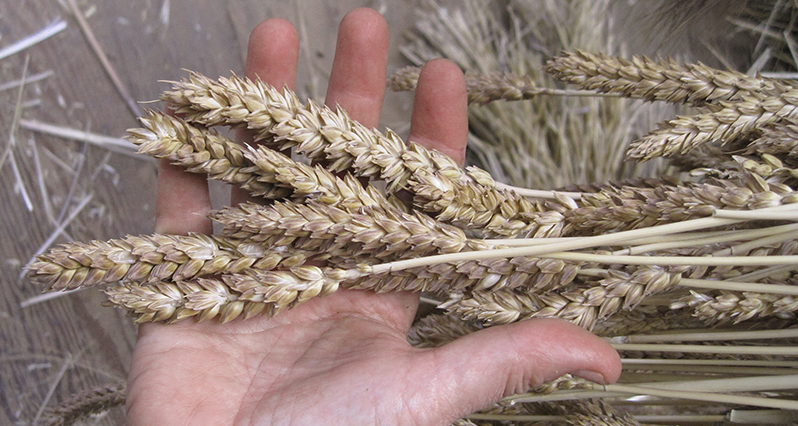|
I suggest growing a backyard plot of grain. Not just to avoid modern "bad for you" wheat, but because it is easy, fun and delicious. You don't have to go all the way back to wild grasses and very ancient grains like einkorn (they are difficult to de-hull for eating.) There are many wheats and barleys from before modern "green revolution" grains were the norm. Generations of farmers raised big healthy families on these heritage grains. The hulless barleys make wonderful pilaf, cooked like rice. You don't even need a grinder to do that. Barley is a very fast-growing spring grain--the main cereal grain in the Himalayas, where seasons are too short for other grains. So you can harvest your barley and still have the space for something else for much of the summer. Foodies are discovering that old wheat varieties like Turkey Red and Banatka have a sweeter, more buttery flavor than modern wheat. Several bakers have commented that they taste like there is honey in the dough, when they is just water, flour, and salt. They are easy to grow and easily prepared for baking. A growing number of gardeners bake bread, tortillas, biscuits, pie, and cookies, from their own heritage wheat. Here is a pie recipe and here is a bread recipe for White Sonoran wheat, which we carry in spring. You can also find recipes that show off the flavor of Banatka and other heritage winter wheats. From the gardener's point of view, grains are easy. They spout fast and grow vigorously, holding and improving the soil when the beds would otherwise be empty or weed-ridden. Grains, like other grasses, have immense root systems that prevent compaction, erosion, and other problems. Gardeners and farmers are discovering that while modern wheats often need a specific and narrow set of conditions for success, many older grains are more flexible and forgiving in their needs. For example most modern wheats are either spring or fall-planted. If you plant a spring wheat in September, it will freeze to death when cold weather comes. And a fall wheat planted in the spring will not produce grain, because it is hard-wired to go through winter before flowering and making seeds. (This is called vernalization, and is common with vegetables, too. Most root crops, as well as cabbage and kale, need to vernalize before blooming.) There are a lot of ancient and heritage wheat varieties that can adapt to either spring or fall planting. These varieties (called facultative grains) can figure out for themselves that it is time to go to seed, whether they experienced winter or not. Banatka wheat and Einkorn both have this ability. Barley breeders are now working on finding facultative barleys. Perhaps modern wheat breeders will rediscover the survival advantages of flexible traits like this. We know such flexibility was critical to the survival of generations of subsistence farmers--our ancestors. They left us a legacy of heritage grains. You can see some of them here.
1 Comment
8/5/2021 08:10:06 am
My mom has been thinking about growing some better grains with her new land. She would really like to get some help from a professional in order to make sure that they are handled properly. I liked what you said about how older grains don't need as much care in order to be successful, and can be more forgiving.
Reply
Leave a Reply. |
AuthorJamie Chevalier lives and gardens on a river in the Coast Range of Northern California. She has gardened professionally in Alaska and California, as well as living in a remote cabin, commercial fishing, and working with seeds. She is the proprietor of Quail Seeds. Archives
July 2024
|
- Home
-
Shop
- Plant for Summer
-
Vegetable Seeds
>
- Arugula
- Beans
- Beets
- Broccoli and Cima di Rapa
- Cabbage
- Carrots & Roots
- Celery
- Chard
- Corn
- Cucumber
- Eggplant
- Fennel
- Genepools and Landrace Gardening
- Greens
- Kale and Collards
- Lettuce
- Melons
- Oil Crops
- Okra
- Open-Source Seeds (OSSI)
- Onions and Leeks
- Peas
- Peppers
- Spinach
- Squash & Pumpkins
- Sunflowers
- Tomatoes
- Tomatillos/Husk Cherries
- Turnips and Rutabagas
- Perennial Vegetables >
- Flower Seeds
- Herb Seeds >
- Seed Collections
- Pollinator and Pest Control Plants >
- Grains >
- Cover Crops >
- Open Source (OSSI)
- Start these Indoors
- People behind the Seeds >
- Companion Plants
- Recipes >
- Fast, Fresh Food
- Plant for Spring >
- Plant for Fall >
- About Us.
- Blog
- HOW-TO
- Mid-to-Late Summer Sowings
Proudly powered by Weebly
- Home
-
Shop
- Plant for Summer
-
Vegetable Seeds
>
- Arugula
- Beans
- Beets
- Broccoli and Cima di Rapa
- Cabbage
- Carrots & Roots
- Celery
- Chard
- Corn
- Cucumber
- Eggplant
- Fennel
- Genepools and Landrace Gardening
- Greens
- Kale and Collards
- Lettuce
- Melons
- Oil Crops
- Okra
- Open-Source Seeds (OSSI)
- Onions and Leeks
- Peas
- Peppers
- Spinach
- Squash & Pumpkins
- Sunflowers
- Tomatoes
- Tomatillos/Husk Cherries
- Turnips and Rutabagas
- Perennial Vegetables >
- Flower Seeds
- Herb Seeds >
- Seed Collections
- Pollinator and Pest Control Plants >
- Grains >
- Cover Crops >
- Open Source (OSSI)
- Start these Indoors
- People behind the Seeds >
- Companion Plants
- Recipes >
- Fast, Fresh Food
- Plant for Spring >
- Plant for Fall >
- About Us.
- Blog
- HOW-TO
- Mid-to-Late Summer Sowings


 RSS Feed
RSS Feed